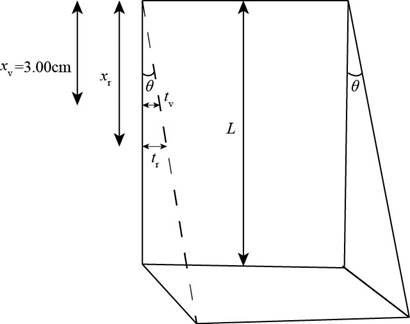
Concept explainers
Figure CQ37.2 shows an unbroken soap film in a circular frame. The film thickness increases from lop to bottom, slowly at first and then rapidly. As a simpler model, consider a soap film (n = 1.33) contained within a rectangular wire frame. The frame is held vertically so that the film drains downward and forms a wedge with flat faces. The thickness of the film at the top is essentially zero. The film is viewed in reflected white light with near-normal incidence, and the first violet (λ = 420 nm) interference band is observed 3.00 cm from the top edge of the film, (a) Locate the first red (λ = 680 nm) interference band, (b) Determine the film thickness at the positions of the violet and red bands, (c) What is the wedge angle of the film?
(a)
The position of the first red interference band.
Answer to Problem 37.70AP
The position of the first red interference band is
Explanation of Solution
Given info: The index of refraction of the soap film is
The diagram of thin film in rectangular wire frame is,

Figure (1)
From figure (1), the formula of tangent of angle is,
Here,
Rearrange the above equation for
The condition for constructive interference for red band in a thin soap film is,
Here,
The condition for constructive interference for violet in a thin soap film is,
Here,
Divide equation (3) by (4) on both sides.
Substitute
Substitute
Substitute
Conclusion:
Therefore, the position of the first red interference band is
(b)
The film thickness at the position of red and violet bands.
Answer to Problem 37.70AP
The film thickness at the position of red band is
Explanation of Solution
Given info: The index of refraction of the soap film is
From equation (3), the condition for constructive interference is,
Substitute
From equation (4), the condition for constructive interference is,
Substitute
Conclusion:
Therefore, the film thickness at the position of red band is
(c)
The wedge angle of the film.
Answer to Problem 37.70AP
The wedge angle of the film is
Explanation of Solution
Given info: The index of refraction of the soap film is
From figure (1), the formula of tangent of angle is,
Substitute
Conclusion:
Therefore, the wedge angle of the film is
Want to see more full solutions like this?
Chapter 37 Solutions
Physics for Scientists and Engineers, Technology Update (No access codes included)
- r 2. Measuring Length mm 1 cm 2 3 INCH 1 16THS 5 6 7 8 9 10 11 FAIRGATE COLD SPRING, NEW YORK 2 3 12 1. Using the metric (top) scale only, what units are being used for the long lines with the numbers? Hint: Remember that 2.54 cm = 1 in. 2. What are the units of the small lines? 3. How many decimal places should be recorded using this tool? 4. What is the length of the red line? Note: Make sure to use the correct units and decimal places. 5. Now observe your ruler. What metric units are used on your ruler? 6. How many decimal places should you record when using your ruler? 7. Measure a box, book, coin and can and fill out the data table below. Make sure to use units and the correct number of decimal places for your ruler. Table 1: Measuring Length Data Table Object Length of the box Length Local PR Distribution Only $99/Release. Get Started On Our Website Now! V 2 217arrow_forwardPROBLEM 3 Cables A and B are Supporting a 185-lb wooden crate. What is the magnitude of the tension force in each cable? A 20° 35° 185 lbsarrow_forwardNo chatgpt pls will upvotearrow_forward
 Physics for Scientists and Engineers with Modern ...PhysicsISBN:9781337553292Author:Raymond A. Serway, John W. JewettPublisher:Cengage Learning
Physics for Scientists and Engineers with Modern ...PhysicsISBN:9781337553292Author:Raymond A. Serway, John W. JewettPublisher:Cengage Learning Physics for Scientists and Engineers: Foundations...PhysicsISBN:9781133939146Author:Katz, Debora M.Publisher:Cengage Learning
Physics for Scientists and Engineers: Foundations...PhysicsISBN:9781133939146Author:Katz, Debora M.Publisher:Cengage Learning Principles of Physics: A Calculus-Based TextPhysicsISBN:9781133104261Author:Raymond A. Serway, John W. JewettPublisher:Cengage Learning
Principles of Physics: A Calculus-Based TextPhysicsISBN:9781133104261Author:Raymond A. Serway, John W. JewettPublisher:Cengage Learning Physics for Scientists and EngineersPhysicsISBN:9781337553278Author:Raymond A. Serway, John W. JewettPublisher:Cengage Learning
Physics for Scientists and EngineersPhysicsISBN:9781337553278Author:Raymond A. Serway, John W. JewettPublisher:Cengage Learning Physics for Scientists and Engineers, Technology ...PhysicsISBN:9781305116399Author:Raymond A. Serway, John W. JewettPublisher:Cengage Learning
Physics for Scientists and Engineers, Technology ...PhysicsISBN:9781305116399Author:Raymond A. Serway, John W. JewettPublisher:Cengage Learning University Physics Volume 3PhysicsISBN:9781938168185Author:William Moebs, Jeff SannyPublisher:OpenStax
University Physics Volume 3PhysicsISBN:9781938168185Author:William Moebs, Jeff SannyPublisher:OpenStax





